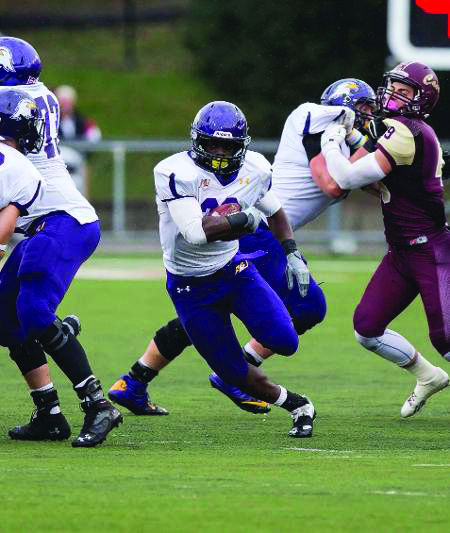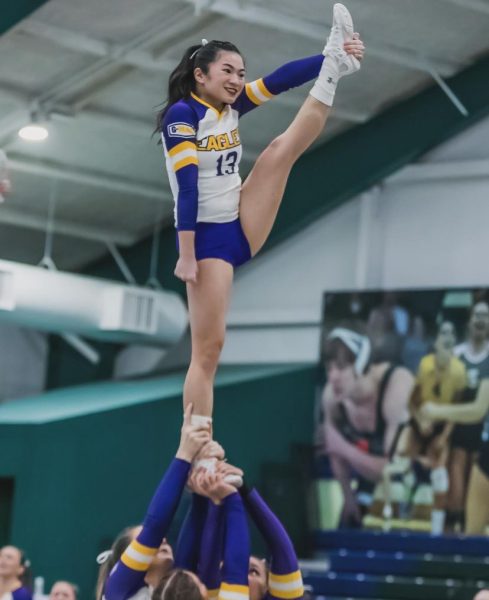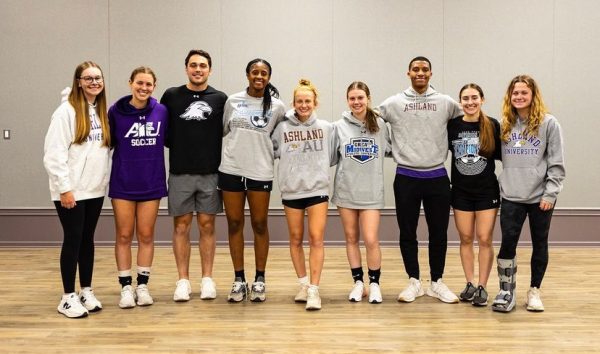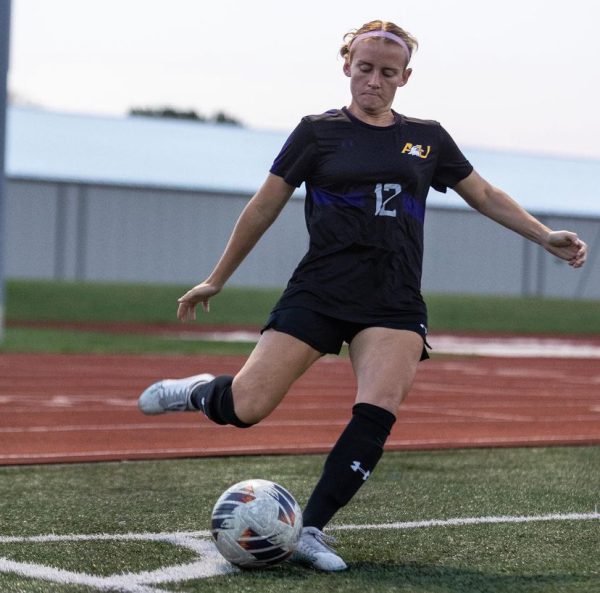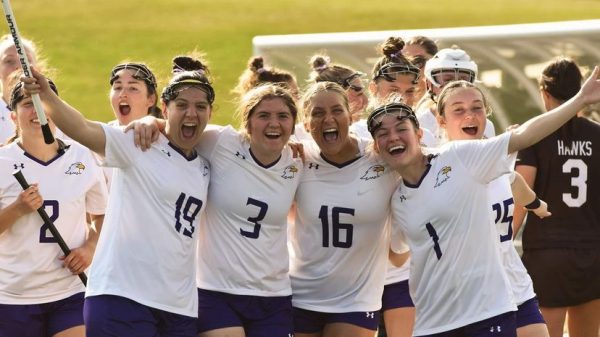Eagles ready to open the college football season
August 31, 2014
In this day and age, it’s common to get football clichés shoved down our throats.
Run the football.
Control the line of scrimmage.
Don’t turn the ball over.
Win time of possession.
Dominate field position.
That’s just naming a few!
Any football fan can make an argument to what his or her favorite team needs to do in order to come out with a win each week.
And all of them think they are right.
The bottom line is that for a team to win, they need to score more points than the other team in 60 minutes of playing time.
Duh. That’s explaining football in the simplest way possible!
Not even for just football, but in all sports, you have to do whatever it takes to score better than the opponent to win. This is the case in pickup basketball at the AU Rec Center and with varsity sports in Kate’s Gymnasium and Jack Miller Stadium.
Even at the professional level in First Energy Stadium and Quicken Loans Arena, the team that comes out on top scores better!
Now obviously this column wouldn’t do its due diligence if “scoring more than the other team” were the only argument. But what if we looked at football in the simplest way possible when looking ahead at the upcoming Ashland football season?
What’s it going to take for AU to win games? Let’s use some common sports comparisons to determine what the Eagles need to do to get back on top of the GLIAC.
Play to your strengths
Before I get into where AU can flex its muscles in the different phases of the game, let’s look at one of two familiar sports headlines from the nearby city of Cleveland.
The King has returned. LeBron James is back with the Cavaliers and he’s brought some friends along to try and win an NBA championship.
LeBron James was once the Cavs’ best player and that will be the case again. Cleveland wants the ball in its best player’s hands in order to win. It worked in getting the Cavs to the NBA Finals before. It only makes sense to let him handle the ball again.
Of course basketball is a different sport than football, and Ashland football doesn’t have LeBron James on its team.
What AU does have is arguably the most depth at running back at the Division II level in the country. Anthony Taylor is the school’s all-time leading rusher. He hasn’t even played his senior season yet.
After sitting the majority of last season out with an injury, Jordan McCune is now healthy. Had he been in Taylor’s role last year, he could have neared former AU running back Keith Weaver’s 3,934 rushing yard record! Vance Settlemire burst on the scene in 2013 replacing McCune as the change-of-pace back and averaged 6.9 yards a carry.
You don’t find that kind of depth often. That’s why it has to be taken advantage of. It doesn’t matter if they are handed the ball or catching it out of the backfield, the ball just has to be in their hands! And it really makes sense to have any one of those three carry the ball with inexperience and uncertainty at the quarterback position.
I’m sure running game coordinator Doug Geiser is licking his chops to call run after run after run after run after run.
Just give them the rock!
Another strength of the AU football program for years has been its defense.
While a defense isn’t exactly going to put points on the board for you too often, this Eagles’ defense has made the big stop when it was needed to keep Ashland in the game.
AU also welcomes back All-American linebacker Cody Bloom after his yearlong absence. His presence in the middle of the field is going to cause havoc for opposing offenses.
In 2013, AU’s defense was relied on heavily due to inconsistent offensive play. While the Eagles gave up only 22.4 points per game, good enough for second in the conference, the defense was on the field significantly more than it was in the Eagles’ 11-1 season in 2012.
That’s all the more reason to rely on the arguably the most important players on the team, the running backs, to control the game and time of possession and keep the defense fresh.
One strength compliments another strength.
How convenient!
But what about the defensive line?
The disruptive force known as Jamie Meder has moved on and is now making plays for the Baltimore Ravens.
How can the defense be as good without an All-American defensive tackle?
Trust in Coach Rose’s Defense
It’s really impossible to replace a player like Jamie Meder, especially with the roster that the Eagle’s currently have.
But this isn’t defensive coordinator Tim Rose’s first rodeo.
In Coach Rose’s six seasons at AU, the defense was a top five scoring defense four times.
He also has a track record of taking poor defenses at Toledo in 2005 and Louisiana Tech in 2004 and reducing their yards per game allowed by over 100 yards per game.
Adjustment isn’t an issue for Rose and his defenses.
In fact, the roster in place could allow Rose to be me more creative defensively than he ever has before at AU.
Preseason All-GLIAC linebacker Chris Harvey is one of the most dynamic pass rushers in the conference. Bloom and Zack Olszewski will man the middle. Transfer Chase Hoobler from Indiana University will also provide a Division 1 caliber talent rushing from the opposite side of Harvey.
All those linebackers, combined with a group of fast down-lineman that will be rotated constantly are going to give Coach Rose a lot of defensive schemes to work with.
Don’t worry about AU’s defense. It’s going to be fine.
Positive consistency at quarterback
There’s no question that the biggest uncertainty with Ashland’s team this year is at quarterback.
Enter our second Cleveland sports reference. Have you ever heard of the Cleveland Browns?
Ever since Browns returned to Cleveland in 1999, the amount of poor play at the most important position on the field is staggering.
20 different starting quarterbacks have taken the field for Cleveland in the past 15 seasons.
That number could become 21 soon with the arrival of Johnny Manziel, but that’s another story.
How many of those seasons since 1999 have been winning campaigns for the Browns?
Two.
Consistent?
Yes.
The consistency a team wants?
Definitely not.
The quarterback shuffle doesn’t work too well.
Now looking back at Ashland’s 2013 season, the revolving door at quarterback to replace 2012 Harlon Hill Finalist Taylor Housewright didn’t exactly work out too well either.
A combination of a then-freshmen-now-sophomore Austin Bruns and recently transferred Tra’von Chapman combined for just 165 yards passing per game, second worst in the GLIAC.
Some of that may have to do with inexperience and not having enough time to grasp Coach Lee Owens’ offense, but that’s not how a team is going to win the GLIAC.
If redshirt freshman Travis Tarnowski is going to be the guy, or Bruns, or whomever, he has to step up and show that he is the unquestioned leader of the offense.
That doesn’t mean he has to be like Taylor Housewright and compete for the Harlon Hill, but whoever it is has to go out and seize the opportunity.
He needs to win the job by showing he can make the throw when it needs to be made or leading a game-winning drive in the fourth quarter.
That’s a lot of pressure to place on a second-year quarterback, but its pressure that should be there for a team that wants to win a conference title in a league like the GLIAC.
It doesn’t have to be Tarnowski. It doesn’t have to be Bruns. But for this team to win a title, it has to be a leader that can make plays when called upon.
As uncomplicated as it sounds to rely on your best players, trust in your coaching staff, and have quality play at the most important position on the field, putting it all together is a challenge and sometimes it isn’t pretty.
But which is prettier, sets of record statistics and a .500 season, or a GLIAC ring on the finger of a team that deserves it?
The answer to that is simple.


